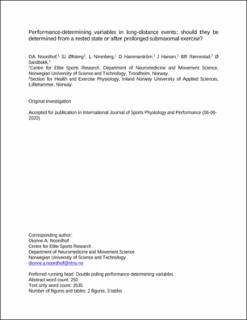Performance-determining variables in long-distance events: should they be determined from a rested state or after prolonged submaximal exercise?
Noordhof, Dionne; Øfsteng, Sjur J.; Nirenberg, Linnea; Hammarström, Daniel; Hansen, Joar; Rønnestad, Bent R.; Sandbakk, Øyvind
Peer reviewed, Journal article
Accepted version

Åpne
Permanent lenke
https://hdl.handle.net/11250/2732055Utgivelsesdato
2020Metadata
Vis full innførselSamlinger
Originalversjon
https://doi.org/10.1123/ijspp.2019-0987Sammendrag
Performance-determining variables are usually measured from a rested state and not after prolonged exercise, specific to when athletes compete for the win in long-distance events. Purpose: (1) To compare cross-country skiing double-poling (DP) performance and the associated physiological and biomechanical performance-determining variables between a rested state and after prolonged exercise and (2) to investigate whether the relationship between the main performance-determining variables and DP performance is different after prolonged submaximal DP than when tested from a rested state. Methods: Male cross-country skiers (N = 26) performed a blood lactate profile test and an incremental test to exhaustion from a rested state on day 1 (D1; all using DP) and after 90-minute submaximal DP on day 2 (D2). Results: The DP performance decreased following prolonged submaximal DP (D1: peak speed = 15.33–20.75 km·h−1, median = 18.1 km·h−1; D2: peak speed = 13.68–19.77 km·h−1, median = 17.8 km·h−1; z = −3.96, P < .001, effect size r = −.77), which coincided with a reduced submaximal gross efficiency and submaximal and peak cycle length, with no significant change in peak oxygen uptake (P = .26, r = .23). The correlation coefficient between D1 cycle length at 12 km·h−1 and D2 performance is significantly smaller than the correlation coefficient between D2 cycle length at 12 km·h−1 and D2 performance (P = .033), with the same result being found for peak cycle length (P < .001). Conclusions: The reduced DP performance after prolonged submaximal DP coincided with a reduced submaximal gross efficiency and shorter peak cycle length. The results indicate that performance-determining variables could be determined after prolonged exercise to gain more valid insight into long-distance DP performance.